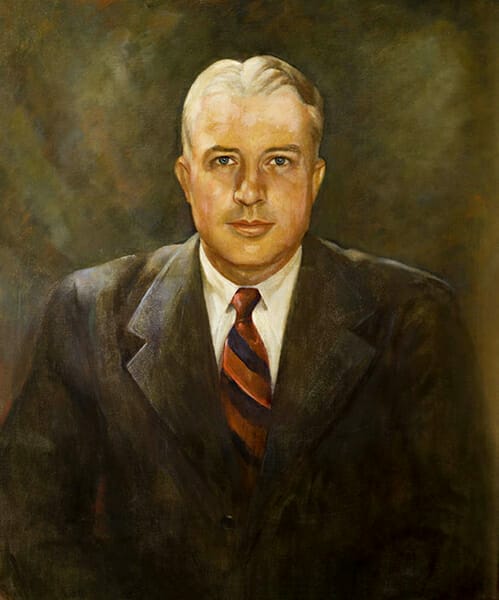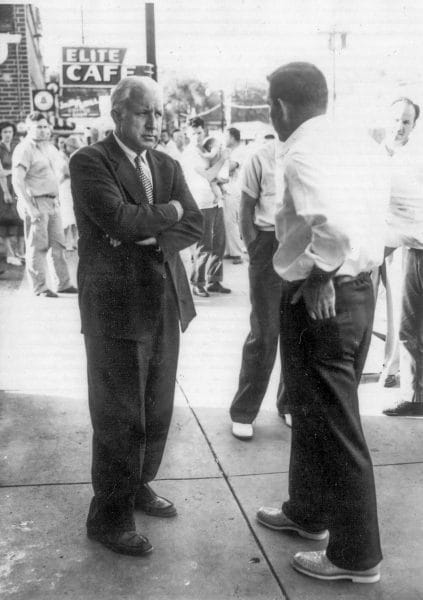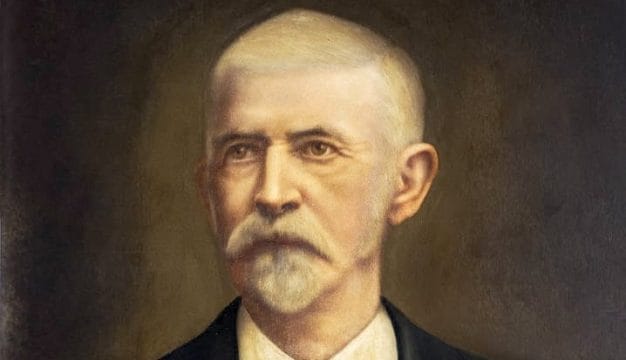Seth Gordon Persons (1951-55)
Alabama’s little-remembered 42nd governor Gordon Persons (1902-1965) is typically overshadowed by his flamboyant predecessor and successor, James E. “Big Jim” Folsom Sr. Persons’s public image—amiable, quiet, and dignified—presented a stark contrast to Folsom’s often outrageous manner. Serving as governor from 1951 to 1955, the congenial Persons was a calming influence in the years following the Dixiecrat revolt and Folsom’s turbulent relations with the legislature.
 Gordon Persons
Persons was born on February 5, 1902, in Montgomery, where his father owned and operated a drug store in their neighborhood. Impatient and ambitious, the younger Persons roared through the streets of Montgomery on a motorcycle while most boys his age slowly pedaled about town on bicycles. A mediocre student, Persons attended four different preparatory schools during his high school career. After graduation, he enrolled in the electrical engineering program at Auburn University in 1921, where his most noteworthy achievement was his presidency of the innocuous “Hobo Club,” a gathering of students who attended all of Auburn’s away football games dressed as hobos. The organization’s name reflected his restless spirit; Persons quit school after one year and moved from job to job during the next several years. He worked for the Farm Bureau, a cotton association, and an IBM factory in Ithaca, New York, and ran a service station in Montgomery. Persons finally discovered his niche when he recognized the potential for radio in Alabama and opened a radio-parts store in Montgomery. On March 20, 1928, he married Alice McKeithen, with whom he would have two children. His success in radio escalated when, in 1930, he and partner Howard Pill founded Montgomery’s first radio station, WSFA.
Gordon Persons
Persons was born on February 5, 1902, in Montgomery, where his father owned and operated a drug store in their neighborhood. Impatient and ambitious, the younger Persons roared through the streets of Montgomery on a motorcycle while most boys his age slowly pedaled about town on bicycles. A mediocre student, Persons attended four different preparatory schools during his high school career. After graduation, he enrolled in the electrical engineering program at Auburn University in 1921, where his most noteworthy achievement was his presidency of the innocuous “Hobo Club,” a gathering of students who attended all of Auburn’s away football games dressed as hobos. The organization’s name reflected his restless spirit; Persons quit school after one year and moved from job to job during the next several years. He worked for the Farm Bureau, a cotton association, and an IBM factory in Ithaca, New York, and ran a service station in Montgomery. Persons finally discovered his niche when he recognized the potential for radio in Alabama and opened a radio-parts store in Montgomery. On March 20, 1928, he married Alice McKeithen, with whom he would have two children. His success in radio escalated when, in 1930, he and partner Howard Pill founded Montgomery’s first radio station, WSFA.
Persons gained his first taste of state politics when Gov. Bibb Graves appointed him chairman of the state Rural Electrification Authority (REA) in 1935. After three years on the job, the entrepreneurial Persons formed his own engineering firm and installed more than 10,000 miles of electrical lines in Alabama. By 1940, Persons had earned a small fortune and was a hero to many farmers who benefited from his efforts to bring electricity to families in rural Alabama. While Persons was becoming a key player in the public scene, he was also growing wary of the powerful influences of the Public Service Commission (PSC), which he felt was inefficient. His desire for reform led to his campaign for the presidency of the PSC in 1940. Persons emerged from the election as the apparent winner, but a recount in several counties ultimately gave the victory to his opponent by fewer than 2,000 votes. Undaunted, Persons returned two years later and won a seat as an associate commissioner, and in 1944 he was elected president of the PSC.
 Persons Family at the Governor’s Mansion
From this position, Persons made his first bid for the state’s highest office in 1946. A serious throat ailment hampered his campaign, and he finished last in the primary race. He continued to lead the PSC; keeping gas, telephone, and electricity rates low and curtailing the influence of powerful utility companies. In 1950, Persons renewed his pursuit of the governor’s office but avoided the bruising battle between those who supported the Dixiecrats in 1948 and those who remained loyal to the national Democratic Party. He opened his campaign by pledging loyalty to the national party, then quickly dropped the issue for the remainder of the race. During the 1950 campaign, Persons travelled throughout the state in a two-seat helicopter, causing a stir among many rural Alabamians who were seeing such a flying machine for the first time. His whirlybird campaign made 385 landings, and one of his competitors labeled Persons the “Man from Mars.” Voters, on the other hand, found the PSC president to be a down-to-earth choice. On a rainy, overcast day in early May 1950, a heavy voter turnout gave Persons 35 percent of the vote, far ahead of the 14 other candidates in the primary. His next closest opponent, Phillip Hamm, who was Folsom’s handpicked successor, trailed with only 13 percent of the vote. Hamm withdrew from the runoff, giving Persons the nomination. In the November election, Persons swamped his Republican opponent with more than 90 percent of the vote. He and his family then moved into the newly purchased Governor’s Mansion on Perry Street.
Persons Family at the Governor’s Mansion
From this position, Persons made his first bid for the state’s highest office in 1946. A serious throat ailment hampered his campaign, and he finished last in the primary race. He continued to lead the PSC; keeping gas, telephone, and electricity rates low and curtailing the influence of powerful utility companies. In 1950, Persons renewed his pursuit of the governor’s office but avoided the bruising battle between those who supported the Dixiecrats in 1948 and those who remained loyal to the national Democratic Party. He opened his campaign by pledging loyalty to the national party, then quickly dropped the issue for the remainder of the race. During the 1950 campaign, Persons travelled throughout the state in a two-seat helicopter, causing a stir among many rural Alabamians who were seeing such a flying machine for the first time. His whirlybird campaign made 385 landings, and one of his competitors labeled Persons the “Man from Mars.” Voters, on the other hand, found the PSC president to be a down-to-earth choice. On a rainy, overcast day in early May 1950, a heavy voter turnout gave Persons 35 percent of the vote, far ahead of the 14 other candidates in the primary. His next closest opponent, Phillip Hamm, who was Folsom’s handpicked successor, trailed with only 13 percent of the vote. Hamm withdrew from the runoff, giving Persons the nomination. In the November election, Persons swamped his Republican opponent with more than 90 percent of the vote. He and his family then moved into the newly purchased Governor’s Mansion on Perry Street.
The silver-haired Persons brought a no-nonsense business approach to the governor’s office. Citing the ongoing conflict in Korea, he rejected the usual inaugural parade and black-tie ball for a simple ceremony and no fanfare. At the inaugural, he stood on the steps of the capitol for the oath of office in a plain business suit instead of the customary morning coat and top hat. He told the assembled crowd that he had no further political ambitions and would thus devote all his energy to Alabama.
Stocky, good-natured, and quick-witted, Persons had a broad, infectious grin that worked well in his dealings with the state legislature. Unlike the previous four years under Folsom, the new governor’s term was marked by harmonious relations with the Alabama Senate and House of Representatives. His goals and programs were simple, conservative, and ultimately successful: He initiated prison reform, increased funding for education, improved highway safety, and encouraged educational television in the state. But his first official act as governor was to call a meeting of the board of trustees at Auburn for the purpose of firing that institution’s losing coach, Earl Brown. They then hired Selma native Ralph “Shug” Jordan, who restored Auburn’s winning football program.
In pursuit of his goals, Persons quietly and methodically went about the business of governing Alabama. He accepted no speaking engagements during his four years in office, preferring to let his record speak for him. Soon after taking office, Persons and the legislature ended fiscal mismanagement in the Department of Corrections and placed the prison system under the control of a new supervisory board. In a vivid public display, Persons burned the straps used to whip convicts in the state and denounced the practice as barbaric.
 Gordon Persons and Jim Folsom Sr.
Despite his deeply held convictions on corporal punishment, Persons ironically threatened to use the lash on a journalist or two. Perhaps his most controversial action as governor was his callous treatment of Geoffrey Birt, a reporter for the Montgomery Advertiser. At a news conference during the summer of 1951, the usually easygoing Persons exploded at Birt, accusing him of unfairly manipulating his words. Two years later, Persons again threatened Birt after he published an article that accused the governor of unethical dealings. The controversy dissipated fairly quickly, however, with no repercussions. Athough he was the subject of some negative press, Alabamians largely recognized Persons for his positive programs. He increased expenditures for highway construction, and in 1953 he instituted a mandated 60-miles-per-hour speed limit during the day and 50 at night. The governor’s efforts significantly reduced traffic fatalities in the state.
Gordon Persons and Jim Folsom Sr.
Despite his deeply held convictions on corporal punishment, Persons ironically threatened to use the lash on a journalist or two. Perhaps his most controversial action as governor was his callous treatment of Geoffrey Birt, a reporter for the Montgomery Advertiser. At a news conference during the summer of 1951, the usually easygoing Persons exploded at Birt, accusing him of unfairly manipulating his words. Two years later, Persons again threatened Birt after he published an article that accused the governor of unethical dealings. The controversy dissipated fairly quickly, however, with no repercussions. Athough he was the subject of some negative press, Alabamians largely recognized Persons for his positive programs. He increased expenditures for highway construction, and in 1953 he instituted a mandated 60-miles-per-hour speed limit during the day and 50 at night. The governor’s efforts significantly reduced traffic fatalities in the state.
Among his other notable legacies, Persons, with his background in radio, was among the first in the nation to see the educational potential that existed through the medium of television. In 1950, at Persons’s urging, Alabama created an Educational Television Commission, becoming the first state to do so. Persons signed “right-to-work” legislation that prohibited enforced union membership as a condition for employment. The law was made possible through a section of the Republican-sponsored 1947 Taft-Hartley Act and came in the midst of a series of postwar strikes during the Truman administration. Not all of Persons’s efforts were positive, however. Governing in the midst of the McCarthy era, Persons signed a bill that forbade communists from holding public office and required them to register their party affiliation. He also supported an amendment that established new ways to disenfranchise blacks as the old ones were being found unconstitutional by federal courts.
Late in Persons’s administration and just before a new gubernatorial election, the Supreme Court of the United States handed down the Brown v. Board of Education of Topeka, Kansas decision outlawing racially segregated facilities in public schools. Persons hoped to reduce anxiety in the state over this volatile civil rights issue and had begun a year earlier studying ways to deal with the long-awaited court decision. A relative moderate on racial issues, Persons had campaigned for governor on a pledge to limit or abolish the poll tax, which eliminated poor voters, both black and white. The legislature passed a compromise measure limiting back unpaid poll taxes to two years and eliminating them entirely for voters over the age of 45. As with many of the state’s white moderates, the governor believed that abolishing segregation was unthinkable, but he refused to call a special session of the legislature to maintain segregation in public education.
 Gordon Persons
In addition to the uneasiness caused by desegregation, another serious domestic problem faced Alabama. Albert Patterson, who had used his campaign of cleaning up corrupt and dangerous Phenix City to win the Democratic nomination for the state’s attorney general slot, was murdered, thrusting his son, John Patterson, into the political limelight. Persons placed Russell County under martial law and sent in National Guard troops to protect citizens from the criminal element that dominated the city.
Gordon Persons
In addition to the uneasiness caused by desegregation, another serious domestic problem faced Alabama. Albert Patterson, who had used his campaign of cleaning up corrupt and dangerous Phenix City to win the Democratic nomination for the state’s attorney general slot, was murdered, thrusting his son, John Patterson, into the political limelight. Persons placed Russell County under martial law and sent in National Guard troops to protect citizens from the criminal element that dominated the city.
Persons could not succeed himself as governor, but his political activism was cut even shorter when, just days before Jim Folsom’s reelection victory in November 1954, he suffered a serious heart attack. He never returned to his office and designated his executive secretary, Vernon Merritt, to read his farewell address to the legislature. Despite his promise never to return to public office, many considered Persons the front-runner for governor in 1958. A mild stroke, however, prevented another serious bid for Alabama’s top job. On May 29, 1965, he suffered a major stroke and died in a Montgomery hospital.
Persons had campaigned for governor on the slogan, “I keep my promises.” He did just that by providing four years of sound, conservative government, the last relatively quiet administration before the turbulent civil rights movement began.
Note: This entry was adapted with permission from Alabama Governors: A Political History of the State, edited by Samuel L. Webb and Margaret Armbrester (Tuscaloosa: University of Alabama Press, 2001).
Further Reading
- Persons, Gordon. File. Alabama State Department of Archives and History, Montgomery.



